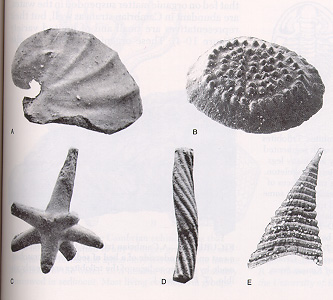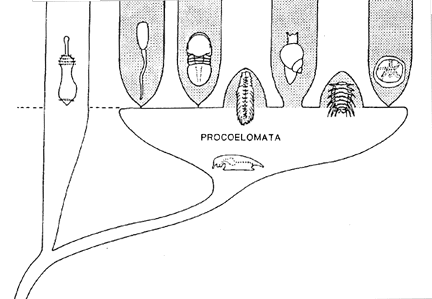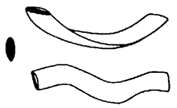
| Terreneuvian Epoch | ||
| Paleozoic: Cambrian Period |
Cambrian age II (Tommotian Age) |
| Fortunian | Terreneuvian | |||
| Atdabanian | Cambrian Epoch 2 | Timescale |
"The wave of discoveries that rewrote the story of the earliest Cambrian began when the former Soviet Union mustered sizable teams of scientists to explore geological resources in Siberia after the end of World War II. There, above thick sequences of Precambrian sedimentary rocks, lie thinner formations of early Cambrian sediments undisturbed by later mountain-building events (unlike the folded Cambrian of Wales). These rocks are beautifully exposed along the Lena and Aldan rivers, as well as in other parts of that vast and sparsely populated region. A team headed by Alexi Rozanov of the Paleontological Institute in Moscow discovered that the oldest limestones of Cambrian age contained a whole assortmentof small and unfamiliar skeletons and skeletal components, few bigger than 1/2 in (1 cm) long. These fossils have been wrapped in strings of Latin syllables but have been more plainly baptized in English as the "small shelly fossils" (SSFs for short).
In 1969, a 380-page monograph was published in Russian describing the unknown fossils, and Paleontologists who now knew what to look for began to discover parallel sequences scattered- in sites from Meishucun in southern China, and India to Newfoundland and Nova Scotia, and from Shropshire to southern Australia."See also The Tommotian Age at Berkeley UCMPJ. John Sepkoski Jr, "Foundations - Life in the Oceans" in The Book of Life, ed. by Stephen Jay Gould, 1993, Ebury Hutchison, London, pp.48-49
Global events such as a major rise in the level of marine carbonates and phosphates triggered the sudden appearance of phosphate rich shelly-organisms. - Carbon Isotope Stratigraphy of the Phosphorite-Bearing Precambrian-Cambrian Transition Series of the Lesser Himalaya (Uttar Pradesh, India) (no longer available)- "a high reading of negative carbon isotope indicates geological events starting with a preceding oceanic anoxic event (OAE). The re-establishment of a well-mixed oxic Late Proterozoic ocean was apparently coupled to the breakup of the Precambrian megacontinent(s) that consequently generated an array of epicontinental seas and bays, notably in the realm of the newly-formed paleotethys. In the wake of restored marine circulation patterns, these shelf areas were inundated by previously stagnant, phosphate-rich seawater, turning the shelves into regions of high primary productivity" (short but technical paper)
The Tommotian was an important period which saw the rise of diversified metazoans with skeletons. This represented the earliest abundant and diverse small skeletonized assemblage stage stratotype in Siberia, and was characterized by a great diversity of SSFs, the first archaeocyaths, primitive molluscs, and inarticulate brachiopods.
The Small Shelly Fauna (SSFs) consists of various calcareous (also some silica, some calcium phosphate) fossils some 1-3 mm long. They represented a variety of organisms: sponges, mollusks, annelids, lobopods, and other forms that do not seem to belong to any recent phylum.
The archaeocyaths were the main Early Cambrian reef formers. They had a distinctive Cone inside a cone structure and a calcareous skeleton. Most were no more than a few centimeters in height
| The Tommotian Age subzones | |||
| Aldanocyathus sunnaginicus | Dokidocyathus regularis | Dokidocyathus lenaicus | |
| Lapworthella tortuosa | Lapworthella bella | ||
 Family Anabaritidae
Family Anabaritidae Illustration from W.D. Brasier "Towards a biostratigraphy of the earliest skeletal biotas" (p.136, fig.7.8), in J.W. Cowie & M.D. Brasier eds. The Precambrian-Cambrian Boundary, Clarendon Press, Oxford, 1989

note: the following passage is from Benchley and Harper, Palaeoecology, pp.123-4
"A distinctive assemblage of small shelly fossils, traditionally labeled the Tommotian fauna. appeared at the Precambrian-Cambrian transition; the assemblage is most extravagantly developed in the lowest Cambrian stage of the Siberian Platform, the Tommotian, which gives its name to the fauna. Much is now known about the stratigraphy and palaeobiogeography of this biota through current interest in the definition of the base of the Cambrian System. Nevertheless the biological affinities of many members of the fauna have yet to be established and, although dominated by minute species, together with small sclerites of larger species, the biota represents the first appearance of diverse skeletal material in the fossil record, some 10 million years before the first trilobites evolved. These faunas also provide opportunities to study the functional morphology of early skeletal metazoans.
This type of fauna is not restricted to the Tommotian Stage; these fossils are also common in the overlying Atdabanian Stage. The less time-specific term, Small Shelly Fauna (SSF) was introduced to describe these assemblages. A variety of phyla united by the minute size of their skeletal components and a sudden appearance at the base of Cambrian are now included in the Tommotian fauna. It probably dominated the earliest Cambrian ecosystems where many metazoan phyla developed their own distinctive characteristics, initially at a very small scale. Soft-bodied organisms had developed some protection against predation and desiccation and support for organs and muscle systems. Functional interpretations are difficult since many of the elements of the fauna are, in fact, sclerites of larger animals such as the halkieriids; moreover, there is still uncertainty regarding the precise identity and affinities of many cap-shaped shells, such as the helcionelloids, in the fauna. Nevertheless some of the mollusk-like shells have been functionally analyzed and suggest that these animals pursued a variety of mobile epifaunal and semi-infaunal life strategies (Peel, 1991); the halkieniids may have constructed U-shaped burrows with their anterior and posterior shells covering the entrance and exit to the burrow system."

 The term "procoelomate" was coined by the Swedish paleontologist Jan Bergström to slug-like bilaterian animals that evolved from ancestral aschelminthes priapulid drawn on the left of the diagram) and gave rise to the various coelomate phyla during the Ediacaran-Cambrian transition. (Lophophorates Brachiopod), Articulate (Trilobite), Mollusca (gastropod) and Deuterostomia echinoderm) illustrated). Genetic (RNA) analysis indicates that the various groups of animals based on the coelomate body plan evolved rapidly from this hypothetical "pro-coelomate" ancestor. This agrees with the paleontological evidence of a "Cambrian explosion"
The term "procoelomate" was coined by the Swedish paleontologist Jan Bergström to slug-like bilaterian animals that evolved from ancestral aschelminthes priapulid drawn on the left of the diagram) and gave rise to the various coelomate phyla during the Ediacaran-Cambrian transition. (Lophophorates Brachiopod), Articulate (Trilobite), Mollusca (gastropod) and Deuterostomia echinoderm) illustrated). Genetic (RNA) analysis indicates that the various groups of animals based on the coelomate body plan evolved rapidly from this hypothetical "pro-coelomate" ancestor. This agrees with the paleontological evidence of a "Cambrian explosion" Illustration from Jan Bergström, "Metazoan evolution around the Precambrian-Cambrian transition", in The early evolution of Metazoa and the significance of problematic taxa, ed. by Alberto M. Simonetta and Simon Conway Morris, Cambridge University Press, p.31 fig.4
 Family Tommotidae
Family Tommotidae  Family Lapworthellidae
Family Lapworthellidae  Family Halkieriidae
Family Halkieriidae
 Aldanella attleborensis
Aldanella attleborensis  Turcatheca crasseochlia
Turcatheca crasseochlia
 Anabarella sp..
Siberian Platform
Anabarella sp..
Siberian Platform

|

|
|
| Torellella curva Siberian Platform sunnaginicus zone | Torellella lentiformis Siberian Platform late sunnaginicus to regularis zone | Torellella biconvexa Siberian Platform lenaicus zone to early Atdabanian |
| Family Protohertzinidae | Family Fomitchellidae |

|
|
| Protohertzina Siberian Platform and elsewhere illustration from W.D. Brasier "Towards a biostratigraphy of the earliest skeletal biotas", in J.W. Cowie & M.D. Brasier eds. The Precambrian-Cambrian Boundary, Clarendon Press, Oxford, 1989 | Fomitchella infundulitiformis showing growth lines like those found in conodonts. scale bar - 0.1 mm Siberian Platform Illustration from Jerzy Dzik, "Early Metazoan Evolution and the Meaning of It's Fossil Record", in Evolutionary Biology, vol. 27, edited by Max K. Hecht et al., Plenum Press, New York, fig. 1 p.342 |
The earliest metazoan reefs at the base of the Tommotian, as exposed on the Aldan River, Siberia, were already ecologically complex (75). While possessing low diversity, they had erect framework elements of branching archaeocyaths, with a cryptic biota of archaeocyaths and calcified cyanobacteria. These reefs were associated with skeletal debris of a diverse associated fauna; microburrowing deposit-feeders continued to proliferate within the sheltered areas of the framework.
By the middle Tommotian, archaeocyath - cyanobacterial reefs became more diverse and ecologically complex (52) due to the appearance of other sessile, calcified organisms inferred to have been suspension- or filter-feeders. These organisms included radiocyaths, a variety of simple cup-shaped forms known as "coralomorphs," globally rare but locally abundant large skeletal tabulate corals and other cnidarians (53, 78), and stromatoporoid sponges (69). Possible calcarean sponges appeared in the early mid-Tommotian (52); probable sponge borings have been noted within coralomorph skeletons from the Canadian Rocky Mountains (70), and silt-sized microspar grains resembling "chips" from clionid-type sponges have been identified within Lower Cambrian reef cavities (50).